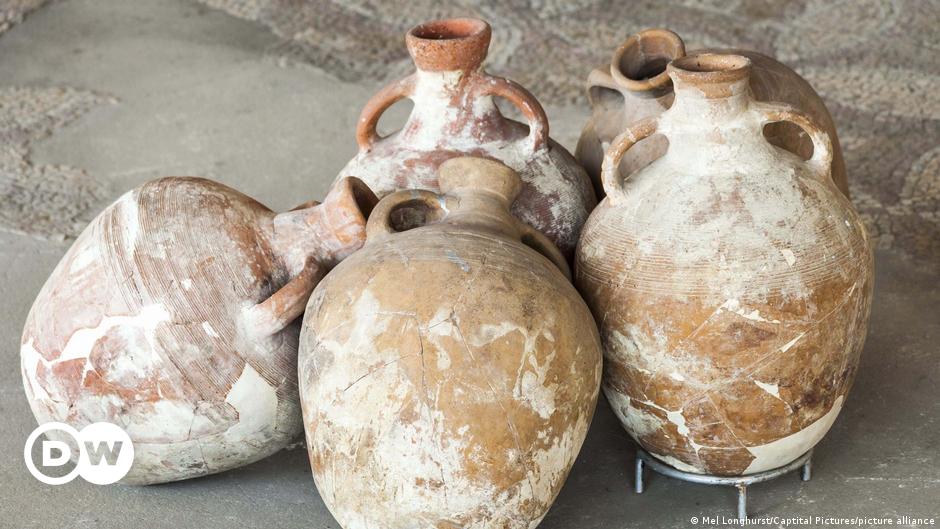Amphorae are like barbies: they cannot stand unaided
Amphorae were mainly made for trade. With the vessels, which held five to 80 liters depending on their size, people in ancient times transported oil, wine, honey, olives, pickled vegetables and garum – a fish sauce that was as popular in Roman cuisine as soy sauce today in asian.
A typical ampore was tapered at the bottom so that it could only stand on a frame or had to be embedded in the floor. However, their shape was ideal for transport by ship, as they could be stored side by side or on top of each other to save space. Large sailing ships had up to 10,000 amphorae on board. An important feature are the carrying handles on both sides. The amphora owes its name to these handles. Because the term comes from ancient Greek and means something like “two-handled clay vessel”.
Amphorae were ideally suited for transport across the seaImage: Martin Moxter/imageBROKER/picture alliance
Amphorae were ancient disposable packaging
The idea that in 400 years archaeologists will analyze rusty plastic beer cans or beverage bottles and exhibit them in museums is curious. But amphorae and modern containers for drinks are not that dissimilar. Amphorae were ancient disposable items. Unless they were elaborately designed vessels, they had standardized sizes – an ancient ISO standard, so to speak. They didn’t cost much to produce and were only needed for transportation.
The vessels were noted, among other things, how heavy they were, where they came from, what goods they contained and when they were shipped by which exporter. When the merchant ships docked at the ports, the amphorae were emptied and had thus fulfilled their function. They were then either broken up on the spot and thrown away or used for a second time, for example as a latrine, a coffin or as light and cheap building material.
Oil, wine, concentrated grape juice, pickled fruit and vegetables, honey and spices were filled in amphorae and shipped throughout the Roman EmpireImage: Paul Williams/Funkystock/imageBROKER/picture alliance
Worthless rubble in antiquity – valuable testimony today
However, vessels in which olive oil was transported – and vast quantities of it were shipped in the Mediterranean region – were no longer of any use. So they had to be thrown away. The clay pots were smashed and simply thrown in a heap or into the sea.
One of these heaps grew over the years to a nearly 40 meter high mound and still exists today. The Monte Testaccio in Rome is such a mountain of shards. Today it is covered with greenery, but it is estimated that more than 50 million remains of ancient amphorae still lie beneath the surface. Because the potsherds do not decompose even after 3,000 years. Such ancient garbage dumps are a treasure for archaeologists, as these finds say a lot about ancient trade routes and the diet of the contemporaries. The origin of the amphorae and their inscriptions show that the goods were transported throughout the Roman Empire and even exported to India and Ethiopia.
Amphorae were a mass product in ancient times – and yet each one was handmadeImage: Martin Siepmann/imageBROKER/picture alliance
A German brought order to chaos
The Germans are known abroad for their love of order. No wonder that a German of all people wanted to bring order to the chaos on Monte Testaccio. The epigraphist Heinrich Dressel (1845-1920) examined the Roman amphorae on the Scherbenberg from 1872 and assigned them to more than 40 different types, some of which are still used today to describe amphorae. He was interested in the shapes, contents and inscriptions of the amphorae. He was thus able to prove that the bulbous amphora of the “Dressel 20” type came from Spain and contained oil, while the widespread oblong type “Dressel 1” amphora was filled with Italian wine.
Keep your hands off ancient cultural assets – that will only cause trouble!Image: Florian Launette/maxppp/picture alliance
If you see an amphora, leave it!
Amphorae were a dime a dozen in the ancient world. In addition, the clay vessels were made of an extremely durable material. That is why they are still found today, mainly on the seabed and in sunken ships. Anyone who finds old amphorae while diving in Turkey, Italy, Spain or Greece should definitely leave them there and report the find to the authorities.
After all, anyone who takes amphorae or fragments of amphorae home as a souvenir is liable to prosecution: the export of cultural goods is illegal and is punished with high fines and imprisonment. A father from Austria, whose children came across fragments of amphorae while snorkeling while on a summer holiday in Rhodes in 2019, is now facing a prison sentence of up to ten years because he took the broken pieces with him as a souvenir.
